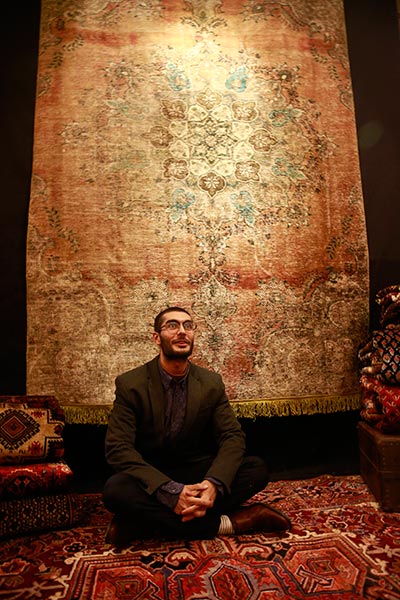 |
|
Matin Zamani displays his collection of handmade Persian rugs at Beijing's Four Seasons hotel. [Photo/China Daily] |
"I saw that there were a lot of cheap rugs and copies of Persian rugs in China," he says. "But I became convinced that I could make people appreciate the real things."
He reaches for a rug made in Hariz, a remote village of about 7,000 people, which has a particular style that's based in pattern and geography.
"The soil is high in copper, which affects the chemical composition of the grass, which affects the chemical composition of the wool-it's very shiny and high fat.
"Because they are distinctive and rare, these rugs are really sought-after," he says. "John Kerry (US Secretary of State) is a big collector of these."
Zamani's romance with traditional rug making is tinged with the realities of modern life, which will inevitably lead to change.
"A 16-year-old girl who is weaving rugs in a small village has Instagram now," he says, chuckling. "She may be posting her progress every time she adds 5 centimeters to a design, and a collector in New York decides he likes it."
A generation ago, Zamani adds, such a girl would never travel more than a few kilometers from her village, let alone have the outside world come to her.
"Now, there is access to the Internet, to books and other things, and so design motifs don't stay isolated as much as they once did."
But handcrafted, naturally dyed rugs have their own character, and inconsistencies in the colors and patterns make each piece unique-a collectable artwork whether it's hung on the wall or spread on the floor. Surprisingly, natural dyes last longer than the chemical colors used in machine-made rugs, which Zamani says can start washing out after a year's wear.
"Village rugs will last for generations," he says.
He's glad to see an end to the US-led sanctions against Iran, which caused the country to lose its place as a leading exporter of "Oriental" rugs.
"During the two or three months before the embargo was enforced," he says, "dealers from New York and Hamburg would sweep through the country, buying half of what was in the bazaars. But it didn't work: The rugs didn't hold their value because cheap copies from other countries soon flooded the market to fill the void."